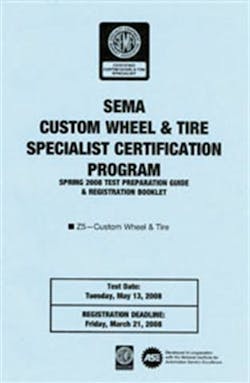Organized tire and wheel training
In 2004, the Specialty Equipment Market Association, or SEMA, used the National Institute for Automotive Service Excellence (ASE) testing process as a base to launch its Z5 Custom Wheel & Tire Specialist certification exam.
Designed to measure “real-world knowledge and skills of the wheel and tire professionals who install custom applications on passenger cars and light trucks,” the exam is held twice a year.
“It is difficult to ascertain the precise percentage of SEMA-member companies that deal with custom wheels and tires,” says Executive Director Ellen McKoy. “The SEMA membership is comprised of many different market segments, including numerous companies that manufacture custom wheels or tires, as well as companies that install and retail these products only.
“In addition, there are many installation facilities that market and install custom wheels and tires along with many other accessories products.”
“It’s important to note, however, that the test is not geared specifically to SEMA-member companies,” she says. “In fact, the certification program is open to members and nonmembers alike, although members receive a substantial discount on registration and test fees.”
To date, more than 550 employees of SEMA-member companies have earned their certification credentials, along with many non-members.
SEMA’s Custom Wheel & Tire Specialist exam is solely a written test and is designed to assess a candidate’s knowledge and expertise. “The test was developed by subject matter experts, both manufacturers and installers, with expertise in this area,” says McCoy.
SEMA’s certification complements ASE certification (see sidebar).
For more information on SEMA’s program, including a listing of available test centers, visit www.sema.org/certification.
[PAGEBREAK]
Hands on with TIA
The Tire Industry Association, or TIA, has taken a more hands-on approach to certified tire and wheel service training.
Its ATS (Automotive Tire Service) passenger and light truck tire training and certification program consists of multiple levels of training; the 400 level certifies the trainee as an instructor, who then can certify other techs.
According to Kevin Rohlwing, senior vice president of training, the ATS program trains the tech or instructor first. If the students demonstrate proficiency in the shop, then they take the certification exam.
At the 400 level, some of the subjects covered during the three- and four-day instructor programs include the following:
• tire construction;
• vehicle lifting information;
• tire/wheel assembly removal;
• tire rotation guidelines;
• tire/wheel assembly installation;
• fastener torque guidelines and procedures;
• demounting, mounting and inflation;
• tire/wheel assembly balancing;
• diagnosing tire and wheel problems;
• load/inflation tables.
The ATS 200 level covers basic automotive tire service and training. It is a self-study program.
As with the SEMA program, ATS training is open to both TIA and non-TIA members. For more information, visit www.tireindustry.org.
[PAGEBREAK]
No tire training with ASE
The National Institute for Automotive Service Excellence (ASE) has been testing technicians since 1972. To become ASE-certified in a specialty, a tech has to have two years of working experience and pass the appropriate automobile service exam.
The automotive-related test subjects include brakes, engine performance, and suspension steering, among others. However, the ASE certification does not test for tire and wheel service.
